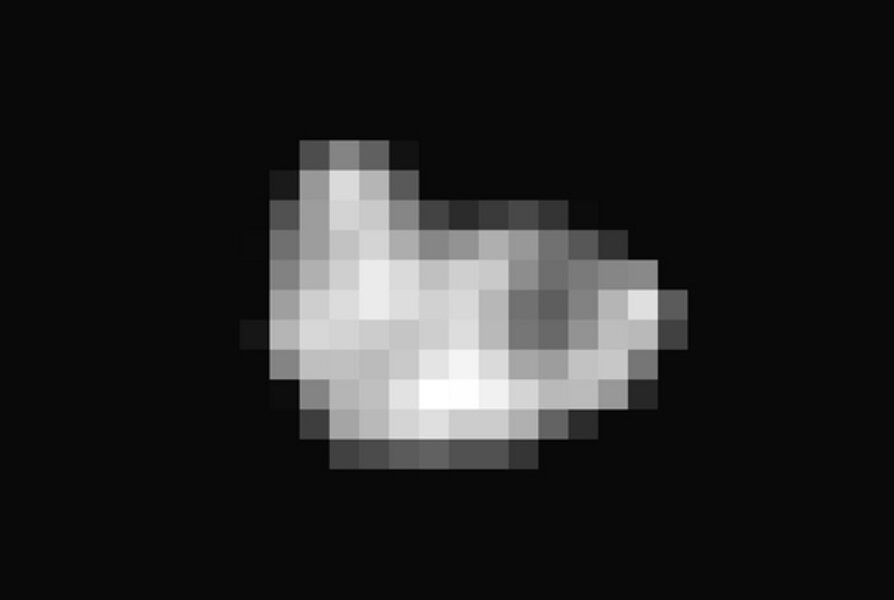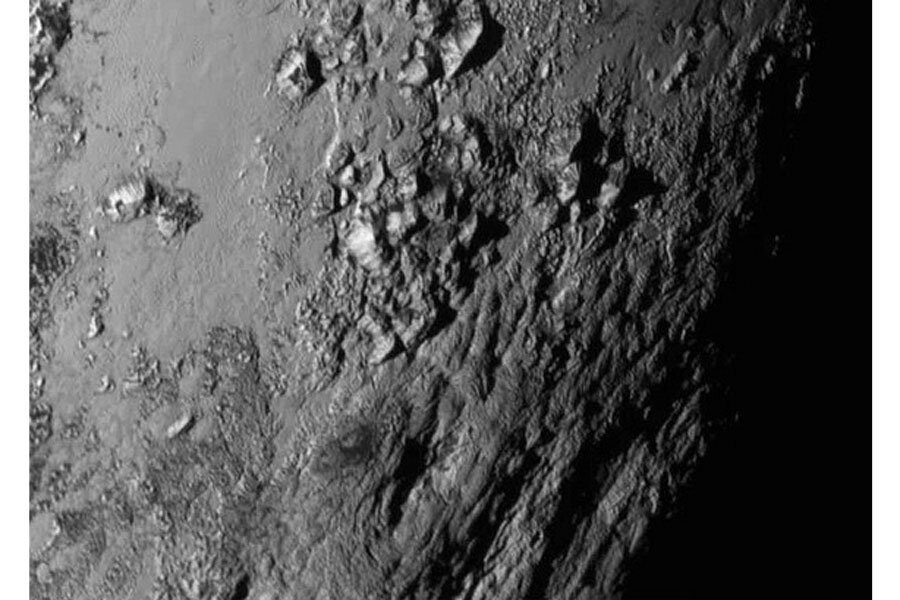Spectacular Pluto photos just the beginning
Loading...
Scientists are stunned at the incredible new images of the surface of Pluto, its largest moon Charon and its farthest-flung moon Hydra, which are just the tip of the scientific iceberg that will be sent back by NASA's New Horizons probe in the wake of its epic flyby.
New Horizons made its closest approach to Pluto at 7:49 a.m. (1149 GMT) Tuesday morning (July 14), but it took almost 24 hours for scientists to get a sneak peek at the treasure trove of data that the probe picked up. It will take 16 months for the spacecraft to beam home the entire volume of information it collected during its historic Pluto encounter.
At a media briefing held today (July 15), leaders of the New Horizons team discussed some of the new images taken during and around closest approach. Among other amazing revelations, the new photos showed that Pluto's surface is surprisingly young and is studded with big, icy mountains; and that Charon has been geologically active recently and possesses canyons up to 6 miles (10 kilometers) deep. [New Horizons Probe's July 14 Pluto Flyby: Complete Coverage]
Hydra
The image of Pluto's most distant moon, Hydra, may look like little more than a pixelated blob, but the clever scientists with New Horizons have used that image to finally determine the size of the elongated satellite — 28 miles by 19 miles (45 by 31 km).
"Prior to New Horizons' revealing of Hydra, we were completely uncertain about how big [it] was," New Horizons project scientist Hal Weaver, of the Johns Hopkins University Applied Physics Laboratory in Laurel, Maryland, said at today's media briefing. "It could have been anywhere from 20 miles [32 km] across to 100 miles [160 km] across."
Weaver said the image shows that Hydra reflects about 45 percent of the sunlight that hits it, and "that can only mean that Hydra's surface is probably composed primarily of water ice. It's the only way to get it that bright. And that's cool."
Weaver said there are more images of Hydra coming soon, which will be two to three times sharper than the image released today.
Charon
"I originally thought Charon might be an ancient terrain covered in craters," said New Horizons deputy project scientist Cathy Olkin, of the Southwest Research Institute (SwRI) in Boulder, Colorado. "Many people on the team thought that might have been the case. And Charon just blew our socks off."
The stunning array of features found on Charon may be even more surprising than those found on Pluto. In the new image, on the upper right edge of the satellite (at about the 2 o'clock position), there appears to be a chunk of material chiseled out of Charon's side. That is actually a canyon that scientists think is anywhere from 4 to 6 miles (6.4 to 10 km) deep. (Earth's Grand Canyon is just over 1 mile, or 1.6 km, deep.) A second canyon on the upper left side is approximately 3 miles (4.8 km) deep.
At Charon's northern pole is a noticeably dark region that Olkin said the team has been (unofficially) referring to as "Mordor." But the dark region might only be a thin veneer over the surface, she said. Near the center of "Mordor," the image reveals a few bright spots that appear to be craters. It's possible meteorites hit Mordor, blasting the dark material away and revealing brighter stuff beneath. The reddish spray of material surrounding the dark region could lend more support to that theory, Olkin said.
Moving across the planet from the northeast to the southwest is a series of troughs and cliffs that extend for roughly 600 miles (1,000 km). [Destination Pluto: NASA's New Horizons Mission in Pictures]
"That's just striking to me. It's amazing to see this," Olkin said. "This is a huge area ,and it could be that it's due to internal processing, and we will be looking at that in more detail."
Below the strip of cliffs and troughs is a smooth region, with very few craters. Earth's moon is covered in craters because it has been pummeled by meteorites for 4.5 billion years. Only a surface that is relatively young — that has been refreshed through geologic turnover — would lack craters.
Olkin said it's possible this region of Charon's surface is geologically active. New Horizons principal investigator Alan Stern, also of SwRI, said this was a big surprise.
"So we've been saying Pluto did not disappoint," Olkin said. "I can add that Charon did not disappoint, either."
Pluto
The close-up image of Pluto's entire face that was released Monday (July 14) wowed the world, but today theNew Horizons team unveiled a small segment of a mosaic image that shows the surface in much greater detail.
The frame covers a region about 150 miles (240 km) wide and features resolution down to 0.5 miles (0.8 km), according to New Horizons scientist John Spencer, also of SwRI.
According to a statement from NASA, the image was taken 1.5 hours before New Horizons' closest approach to Pluto, when the craft was 47,800 miles (77,000 kilometers) from the surface of the planet.
The surface of Pluto in that small region harbors an incredibly varied landscape, including ice mountains and other strange swells of material. [1st Up-Close Photos of Pluto and Charon Unveiled (Video)]
"There's a region that looks sort of hillocky and a region that looks like a fault," Spencer said. "And that terrain down towards the lower right looks really strange. It's like … piles of stuff with grooves on it.
"And then we have smooth flowing plains filling in some of the low spots," he added. "There's been erosion, there's been mountain-building, there's been whatever produces lumpy terrain with grooves on it. And it's baffling. It's baffling in a very interesting and wonderful way. And I hope that when we get more context and we can fill in how this fits in with the rest of the geology, it'll start to make some sense. We can only hope."
According to Spencer, the mountains New Horizons spotted on Pluto reach heights of 11,000 feet (3,500 m) above the surface, and there "may be higher ones elsewhere." (The highest peaks in the Rocky Mountains are around 14,000 feet, or 4,200 m).
"We know the surface of Pluto is covered in a lot of nitrogen ice, methane ice, carbon monoxide ice," Spencer said. "You can't make mountains out of that stuff. It's just too soft, it doesn't have the strength to make mountains on Pluto."
The researchers therefore theorize that the mountains must be supported on a bedrock of water ice, which, at the cold temperatures on Pluto's surface, is hard enough to form tall mountains.
"So the nitrogen and the methane are just a coating on top of this icy bedrock," Spencer said.
But even more surprising than the presence of mountains on the dwarf planet's surface was the lack of craters.
"Pluto is being bombarded by other Kuiper Belt objects — craters happen," Spencer said. The smooth terrain implies that the dwarf planet has been geologically active quite recently.
"Just eyeballing it, we think it has to be probably less than 100 million years old," he added. "It might be active right now. Without craters you just can't put a lower limit on how active it might be."
In a statement from NASA released shortly after the media briefing, Jeff Moore, leader of New Horizons' geology, geophysics and imaging team, said the surface appears to be "one of the youngest surfaces we’ve ever seen in the solar system."
Geologic activity has to be driven by an energy source. In the geologically active icy moons that orbit Saturn and Jupiter, scientists "usually attribute this to tidal heating, or deformation of these worlds by the gravity of that giant planet and interactions with other moons," Spencer said. "That can't happen on Pluto, because there is no giant body that can deform it on a regular basis. This is telling us that you do not need tidal heating to power geologic activity on icy moons. That's a really important discovery that we just made this morning."
Spencer said more frames from the high-resolution mosaic image of Pluto's surface will be released on Friday (July 17), and that those will "show equally amazing things I'm sure. So stay tuned."
Follow Calla Cofield @callacofield.Follow us @Spacedotcom, Facebook and Google+. Original article on Space.com.
- Eyes On Pluto - How Our View Has Changed | Video
- Flying By Pluto-Charon - 4 Days Of Images Compiled | Video
- Will NASA Send An Orbiter or Lander To Pluto? | Exclusive Interview Video
Copyright 2015 SPACE.com, a Purch company. All rights reserved. This material may not be published, broadcast, rewritten or redistributed.









